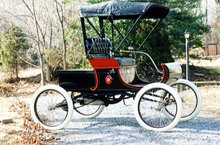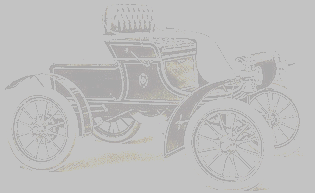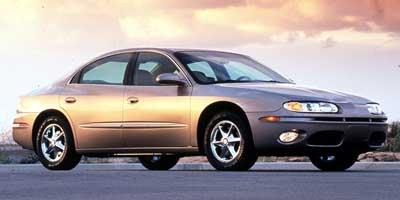|
Gasoline-powered 1901 Oldsmobile resembles buggy
BY VERN PARKER
 Oldsmobile, founded in 1897, was almost put out of business in
March 1901. Until then, the company had not produced many vehicles, but had
built quite a few prototypes to determine which offered the best chance of
commercial success.
Oldsmobile, founded in 1897, was almost put out of business in
March 1901. Until then, the company had not produced many vehicles, but had
built quite a few prototypes to determine which offered the best chance of
commercial success.
All of the prototypes were stored in a Detroit building when it caught
fire and, according to company legend, Oldsmobile employee James Brady, braving
the smoke and flames, pushed the curved-dash model to safety. All the other
prototypes were destroyed by the fire.
Oldsmobile reportedly sold 435 of the curved-dash models in 1901. It was
easily the most popular car of the era. The curved-dash Oldsmobile essentially
was a wooden buggy body, with no provision for a horse, and a tiller to steer
the 8-foot-long vehicle. Riding on a 67-inch wheelbase, the 700-pound Oldsmobile
was powered by a single-cylinder, four-cycle engine. It sold for $650. The
popular curved-dash Oldsmobile runabout was advertised as costing less to
own annually than keeping a horse.
- Oldsmobile is the oldest continuing car marque in the U.S.

- In 1893 R. E. Olds exported a 4-wheeled steam engine vehicle to India to become
the first American automobile exporter. The purchaser never received the
vehicle as the ship transporting it sunk!
- The Olds Motor Co. was incorporated in 1897. The initial capital
investment was $50,000.00!
- In 1897 the company produced 4 automobiles.
- In 1897 Olds offered his first gas powered vehicle to the public.
The asking price was $1,000.
- R. E. Olds was affiliated with Oldsmobile. All of eight (8) years;
from August of 1897 through January of 1904.
- The full name "Oldsmobile" appeared in 1900. Prior to that,
they were known simply as "Olds".
- Ransom Eli Olds also put his name on a line of trucks: REO's
-
The name "Oldsmobile" resulted from a contest R. E. Olds ran to name his
vehicles. It was suggested by a timekeeper at the Olds Motor Vehicle Co. in
1900.
-
Oldsmobile was the leading American automobile producer from 1900 through 1903.
- In 1901 Olds employee Roy Chapin drove a Curved Dash Olds from Detroit to
the New York Auto Show.
In later years he went on to found the Hudson Motor Car Co.
- The Oldsmobile "Pirate" was a world speed record setting automobile.
In 1903 the Pirate traveled a distance of 5 miles in 5:49 minutes at Ormond
Beach, FL. This computes out to a whopping 52 M.P.H.!
-
A steering wheel first appeared on an Oldsmobile in 1904.
- In 1904, R. E. Olds went into competition with Oldsmobile. After
leaving the company, he formed REO Motor Vehicles. In the years of
'05 and '06 more REOs were sold than Oldsmobiles!
- Oldsmobile did have some involvement with railroads. It manufactured
a railroad inspection car which basically was a Curved Dash without the dash and
with railroad wheels. In 1904 it formed and began operating the Lansing
Manufacturer's Rail Road to provide a link from the factory to the rail
transport center in Lansing, MI. Additionally, Olds engines powered both
boats and a Cessna aircraft.
- Oldsmar is a community in the state of Florida. It is north of
Clearwater and west of Plant City.
It was founded by R. E. Olds.
-
G. M. welcomed Oldsmobile into the family in 1908.
- The President of Olds from 1913-16 was Charles Nash. He later
founded - you figure it out!
- A V-8 engine first appeared in an Oldsmobile in 1916. Olds installed a
L-head V-8 in its touring car.
The engine had 2.88 x 4.75 bore and stroke, was 246 c.i. and produced 40 horse
power. It sold for $1,295.

- Steel wheels were introduced by Oldsmobile in 1924. They were
offered as a factory option
and replaced the wooden spoked wheel.
- At the worst possible time, 1929, Olds manufactured and sold a vehicle
named Viking. It was a luxury motor car for the upscale buyer. The
Viking line lasted all of two (2) model years, 1929 and 1930! A total of
8,003 were manufactured. The selling prices were $1,695, $1,795 and
$1,855. All had 261 c.i./81 h.p. V-8 engines; compared to the Olds
standard fare of a 6-cylinder, 198 c.i./62 h.p. engine selling for $875 to
$1,190.
- In 1934 Oldsmobile introduced Hydraulic brakes, independent front wheel
suspension, and the vent (cozy) wing window for "draftless" driving.
-
In 1937 Olds debuted the Automatic Safety Transmission (AST). Strange as
it may sound, you had to depress the clutch pedal to shift between the low and
high ranges!
-
Olds presented the Hydra-Matic transmission to the motoring public in 1940.
- The 303 c.i. Rocket V-8 first appeared in 1949.

- The first time Oldsmobile led the pack as a pace car at the Indy 500 was
in 1949.
- A fire at the Olds Hydra-Matic plant in 1954 necessitated use of Dyna-Flow trannys
in approximately 23,000 Oldsmobiles.
-
The first 4-Door Hardtop was introduced by Oldsmobile in 1955.
-
In 1959 the inaugural Daytona 500 was won by a 1959 Oldsmobile. Lee
Petty took the checkered flag.
- Oldsmobile holds the distinction of pioneering front-wheel drive in 1966.
It was introduced on the Toronado.
- In 1967 Olds set the world closed course speed record at 257 M.P.H. A. J. Foyt was at the wheel.
- Oldsmobile was the first auto manufacturer to make an airbag available.
It was a feature on the 1974 Toronado.
HOME
|


![]()
![]()